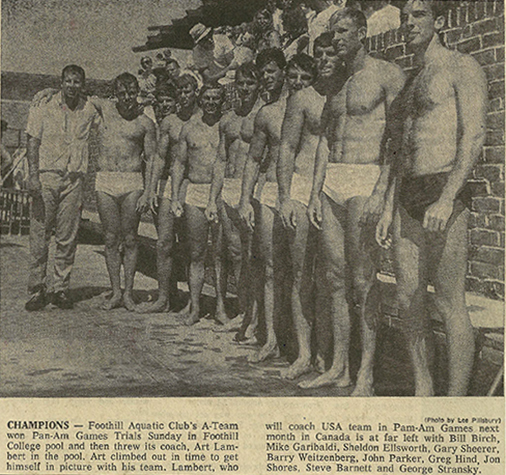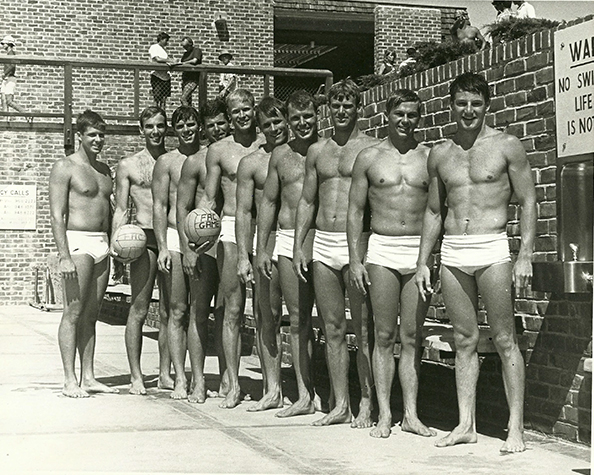April’s “HINDsight 2020” – a monthly share where we take a moment to reflect on our history to celebrate and be inspired.
Some people always find the bright side, the potential, the opportunity. Our founder, Greg Hind, was one of those. So was his former water polo coach Art Lambert. When Greg was just 21 years old he was a part of this historic water polo story shared in Sports Illustrated by Gary Ronberg in 1967.
A team so good it makes two
by Gary Ronberg in Sports Illustrated Aug 21, 1967 https://vault.si.com/vault/1967/08/21/a-team-so-good-it-makes-two
If you were a stickler for the truth and didn’t care what it sounded like, you might say that the national water polo championships in Chicago last week were rigged from the start. But that, in a sense, was the whole point. For years the AAU has tried to sift out the best club team in the country via a national tournament, only to have the victorious team clobbered by outsiders in the Pan-American Games and the Olympics. The U.S., in short, has not been a big water polo power—up to now.
Last month, however, a water polo coach named Art Lambert journeyed to Winnipeg with a team of swimmers he had culled out of the two top teams in the Pan-American tryouts, Foothill Aquatic of Los Altos, Calif. and Inland Nu-Pike of Long Beach, Calif. One result of this was the first gold medal ever won by U.S. water poloists in international competition outside the country. Another: a somewhat lopsided outlook for the national championships scheduled for Chicago. To keep the new champs busy there, the AAU decided to split the Pan-Am squad into two teams, Pan-Am Blue and Pan-Am White, commit them to a tournament with the best clubs in the land—and stand back. That at least seemed certain to provide some competition, and so it did. The two Pan-Am teams promptly eliminated all the others, met each other in a lively exhibition (Blue won 5-4) and left together for Milan aboard an Alitalia jet to take on the world. From the general mien of those sleek, strong, long-muscled schoolteachers, psychologists and engineers-to-be, the world had better watch out. “For the first time ever we’ve got a truly national team,” says Lambert.
Art Lambert has been playing and coaching water polo for most of his 31 years, although at first glance you might think he had been playing Wally on Leave It to Beaver. “Actually, I was a little surprised,” he admits concerning his Pan-Am triumph. “I coach Foothill in the regular season and we were a freelance, ad-lib team. We capitalized on mistakes. Inland, on the other hand, was more patterned and mechanical. Frankly, I was worried that players used to different styles might have trouble jelling, but just the opposite happened. They complement each other. This team plans ahead, but at the same time it is both aggressive and opportunistic.”
It is also in shape. Water polo is a brutal, lung-bursting combination of soccer, basketball and skin diving. It demands top physical conditioning, especially when played in the 30-by-20-meter Olympic pools. But its popularity is on the rise. “Not too long ago,” says Dave Ashleigh, a four-time water polo AAU All-America, “high school coaches used water polo strictly as a conditioner for their swimmers. Nothing else. They insisted the game was too rough. Now you see more and more coaches using swimming as a conditioner for water polo.”

The result has been competitors like Ashleigh and Gary Sheerer, who at 20 was the outstanding player in the Pan-Am competition. By the time he graduates from Stanford engineering school in 1969, Sheerer might be one of our finest water polo players ever. Dean Willeford, a member of USC’s 800-yard freestyle relay team, is another four-time AAU All-America, and Greg Hind, 21, has been chosen twice. This whole U.S. team is young—only one member is more than 24 years old—and the only thing it appears to lack is experience in international competition.
But that’s where Tony Van Dorp, the 31-year-old goalie, comes in. Van Dorp is big (6’5″, 210 pounds) and smart and he is a veteran of international water polo. Born in Indonesia, he played for the Dutch National Team in 1954 and 1955 and has since been an AAU All-America for three straight years. He cruises in front of his net like some kind of mustached destroyer, rising out of the water to repel almost sure goals. On penalty shots, when a fouled opponent sets up 10 feet away with one chance to whip the ball past him, Van Dorp is the picture of composure. Gazing into the bleachers, up at the clouds, winking at friends, he will do anything he can to unnerve the shooter. At Winnipeg he stopped 50% of the penalty shots aimed at him. The going average is somewhere around 10%. “He steadies us,” says Ashleigh, who plays in front of Van Dorp. “He’s been around and he talks to us a lot. And we know that with him in the net one mistake isn’t about to kill us.”
European water polo teams have a tendency to he back and lurk in their own end, waiting for the opposition to carry the attack to them. But with Van Dorp in the nets, Lambert has his team roaming all over the pool, capitalizing on superior swimming ability and conditioning, provoking and forcing errors from the opposition. And they are noisy. “We communicate,” says Sheerer. “Just listen. Everybody knows where the ball is and what’s happening to it. If he doesn’t see it, somebody is yelling at him, telling him.”
Lambert has had his players together since June 26 and he will keep them that way until September 7, when they return from Europe. Next spring they will train for the Olympic Games in the rarefied air of the Air Force Academy and this fall they hope they can meet Hungary, Czechoslovakia and some other water polo powers in the Little Olympics in Mexico City. There is, however, a catch: like almost every team sent out into the world to represent American prowess in a minor sport, the best water polo team in the country must operate on a shoestring.
The team stayed at the Conrad Hilton on Chicago’s Michigan Avenue last week for one reason—a special rate of $4 per day. They ate at Tad’s Steak House and at Wimpy hamburger stands, then lounged in the lobby until the painful trip to the Portage Park Pool, 30 minutes to the northwest on the John F. Kennedy Expressway. There was only one car for all 15 players and their three coaches. Once Sheerer poked his blond hair through a tangle of arms and legs in the back seat and yelped, “Gee, Art, I know you tell us to play like the Green Bay Packers but, really, did you ever see 10 Green Bay Packers in the same Mustang all at once?”
It would be nice if the Packers of water polo could come up with some of that nice green seaweed.

Leave a Reply